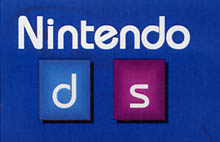
NEW YORK (CNN/Money) � As Nintendo looks to its future, it's also looking to its past. And it's hoping to find profit in both.
The future is more exciting, of course. In just under six weeks, the company will take the wraps off of its latest gaming machine � currently referred to as the Nintendo DS. Among the revelations it has in store are the release date for the system, the suggested retail price � and the final name.
Though the company has publicly referred to the system as the DS since announcing it on Jan. 20, the plan was never to use that name at retail, according to Reggie Fils-Aime, Nintendo's executive vice president of sales and marketing. (The GameCube, similarly, went under the public codename "Dolphin" until shortly before its launch.)
Internet rumors have suggested that system will be called "Nitro," but the company has not commented on this.
Nintendo will unveil the DS � or Nitro or whatever it's being called � at the Electronic Entertainment Expo (the gaming industry's annual trade show) in May, as well as set the release date and initial price. So far, Nintendo has said the system will launch this fall, but Fils-Aime hedged a bit when I asked him if he could confirm a 2004 release in North America. ("As we're sitting here, that's the plan," was all he would say.)
 |
|
| It figures. Right before they change the name, we finally get a logo for the Nintendo DS from the company. |
A North American delay wouldn't be fatal, but it would eliminate Nintendo's headstart against Sony's PSP, which recently delayed its North American launch until early 2005.
The new system will represent a departure for the company, in that the DS/Nitro will likely do much more than play games. A two-hour movie has been successfully tested on the device and wireless gaming and Instant Messaging capabilities are also expected to be included.
Perhaps as part of this departure from its norm, Nintendo is targeting a slightly different audience for the DS/Nitro. Fils-Aime said the company is trying to attract "early adopters who are looking for more complex gameplay and the gamer who has a little more money to spend."
When it was first announced, the DS/Nitro was met with resounding skepticism by gamers. While that has tempered somewhat as details about the machine have leaked out, there's still a sense of wariness. Fils-Aime said he understands the hesitancy.
"The gamer needs to see it, to see the games, to see the full functionality of the machine. ... That's why we're reticent to give details until we can show it," he said. "If I was a gamer and I only saw bits and pieces of a platform, I'd be skeptical too."
Handhelds won't be the only focus of Nintendo at E3. The company also plans to discuss its next generation home console (which will compete with Sony's (SNE: Research, Estimates) PlayStation 3 and Microsoft's (MSFT: Research, Estimates) Xbox 2), said Fils-Aime. It remains unclear whether that discussion will simply be a reiteration that work is progressing and on schedule or if Nintendo will reveal specs for the new machine (which is expected to see a 2006 release).
"Comment on this will come from the highest levels," said Fils-Aime. "The focus and commitment we have on this will be shown at E3."

| |
|
More columns? Click 'Mario'
|
|
While talk of future platforms is certain to get the most attention, Nintendo is also flexing the muscle of its deep catalog to keep the bottom line healthy. In addition to offering updates to classic titles for the GameCube ("Paper Mario Story" will be released in October, "Metroid Prime 2" hits streets in November and "Mario Tennis" is due in December), Nintendo has unveiled a "classic" line of titles for Game Boy Advance owners.
Starting next month, the company will release GBA versions of eight of the biggest games for the Nintendo Entertainment System, the company's first home console system, released in 1985. Games like "Excitebike," "Donkey Kong" and "Super Mario Bros." will be released individually for $20.
Twenty dollars is a hefty price for a 20-year old game, but consumers haven't seemed to care much so far. In Japan, where the classic GBA games were released several months ago, the company sold 900,000 copies in just four weeks.
Fils-Aime said the company is already planning a second wave of classic games for the GBA, with a possible launch date of the 2004 holiday season.
Make no mistake, Nintendo has a lot of catching up to do in this generation of machines and it faces an uphill battle in the coming battles. But in branching out, taking some risks and finding new ways to utilize its game catalog, the company's finally showing some signs that it may have learned from its mistakes.

Morris is Director of Content Development for CNN/Money. Click here to send him an email.
|

